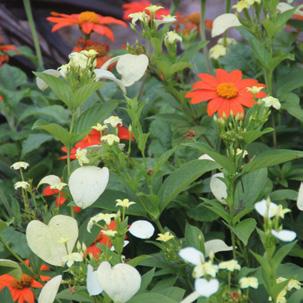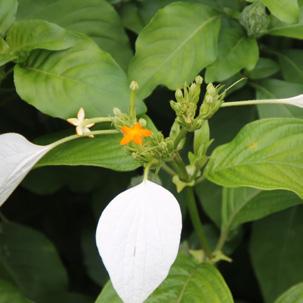
3 minute read
Mussaenda Musings
by Jon Roethling
As I believe many people have figured out, I am a plant nut to the fullest extent. I get no greater pleasure than introducing people to new plants, especially ones that I happen to find interesting. Hearing “what is that?” is simply music to my ears.
Advertisement
One group of plants that I have delighted in bringing to Reynolda is that of the genus Mussaenda and its kin. Belonging to the RUBIACEAE, Mussaenda shares familial ties with the likes of our native buttonbush (Cephalanthus), Cape jasmine (Gardenia) and coffee (Coffea) to name a few. Hailing from the tropical regions of Africa and Asia, they are strictly tender plants for our region but well worth inclusion in our summer gardens.
Much like our native dogwood, the show really comes from the petaloid sepals (modified leaves) rather than the actual flowers. Ranging in color from white to pink to coral to red, the bracts persist for a long period of time, much longer than the actual flowers.
Care during the summer primarily involves providing plenty of sun and fertilizer as they are heavy feeders. The tricky part comes toward the end of the season. Our early dips into the mid-40s in September revealed several of our taxa did not appreciate the cooler temps and they promptly dropped their leaves in disgust. We dug the plants and brought them into the greenhouse where they tend to prefer being a bit on the dry side and not venturing below 50 degrees.
Despite there being close to 100 species, we typically only have a few present in cultivation as well as some wonderful hybrids. Currently we have 7-8 taxa in the collections here at Reynolda. We do plan to have a handful available at the Spring Plant Sale but they may be in short supply.
Pseudomussaenda flava White sepals paired with yellow flowers. Quart sized plants developed into 3’x 3’ plants. Mussaenda erythrophylla Sometimes called Ashanti Blood, red flag bush or tropical dogwood. Brilliant red velvety sepals with bright white tubular flowers were a constant showstopper in the gardens this year. Our 3 gallon size plants reached 4’ x 4’. Mussaenda frondosa Brilliant white sepals paired with orange tubular flowers. We were limited to one stock plant this past year but on the Mall in D.C. at the Smithsonian these were stunning potted specimens, drawing lots of comments. Breeding at the University of the Philippines Los Baños has yielded the following cultivars. Many are names for former Philippine First Ladies and are denoted by “Doña” in the cultivar name. Mussaenda ‘Doña Aurora’ Dark green leaves made the brilliant white floral display stand out even more with the orange tubular flowers punctuating the show. A 3 gallon plant reached 4’ tall by 4’ wide this year. We hope to increase stock on this beauty for next year. Mussaenda ‘Doña Luz’ Large peachy bracts with yellow flowers. Our 3 gallon size plants tended to be more upright growing reaching about 4’ tall by 2’ wide. The leaves were almost hidden due to the plants being covered in blooms for a good portion of the summer.



THERE’S ALWAYS

NEXT SEASON Mussaenda ‘Calcutta Sunset’ We hope to see more out of this plant next year as it was in poor health when it was planted. Showy yellow and salmon deepening to yellow and orange sepals make this one worth watching for next year.
Mussaenda ‘Queen Sirikit’ Named after the Queen of Thailand to commemorate a visit to the Philippines. We thought we had this cultivar but it turns out we were shipped the wrong one. We are definitely planning on adding this to the collection next year. Light pink bracts with a darker edge and yellow flowers.







